|
|
Close to a hundred years ago, Wyberba valley was a thriving settlement of family houses, stockyards and farming land. While little now remains, their presence is remembered and tributes are paid by many areas in Girraween retaining the names of these special people.
The first farmers in the area took up their blocks in 1898. They mostly ran sheep until two years later when Harry Greiss, a German immigrant, introduced cattle and began growing vegetables.
Selections were taken up slowly and their occupants changed frequently. Many selectors walked off their blocks, finding the conditions for farming too difficult or isolated. Some stability came to the district in the 1920s when more people began establishing orchards and small crop farms in the Wyberba valley. Cattle and sheep grazing continued in the east and south.
Around 1916, the Taylor family lived in a highset house situated at the base of the present day first Pyramid. This elegant house of its time was named "Ericdale" - after the owner Eric Taylor. The family grew fruit and vegetables and had cows for milk and butter. The house changed hands many times until the last owner (Hock Goebel) sold the property to the government, to become part of the national park, in the late 1970s.
|
|
In 1919, Bob Boyden - a returned soldier from the First World War - had a one-room shack near "Signboard" in an area now locally known as Boyden's Paddock, east of Underground Creek. Bob cleared the area for farming, but soon enough took the opportunity to swap with the McMeniman family for better farming land in the main valley. For 27 years he successfully grew fruit and vegetables and built four houses, in which he lived at different times.
The McMeniman family ran stock in the main valley of the present day Girraween until they did the swap with Bob Boyden for his selection at "Signboard". The family continued farming at "Signboard" until the late 1970s, when the government purchased their property for expansion of the national park.
|
|
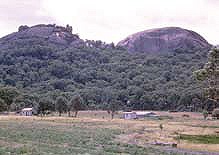
Bob Boyden's third house.
|
|
During the 1920s and 1930s, Bob "Dingo" Smith ran a dairy on the "320" acres near South Bald Rock, in south-east Girraween. Bob was nick-named Dingo because he was renowned for knowing more about the area than a dingo. Dingo Swamp is named after him. Dingo carefully stored and cooled his dairy's cream in a Coolgardie safe and, three times a week, he would take the cream by horse and cart to Wallangarra to send on to Warwick's butter factory by train. However in summer, by the time the cream made it to Warwick, it would be off and had to be thrown out. Needless to say, Bob Smith gave up!
|
|
Also in the 1920s, Paddy Ryan and his partner "Norman" operated a steam mill in a block north-east of the present day Dr Roberts' Waterhole. Blackbutt was felled from what is now national park and sold as house timber. Paddy and Norman lived in tents, but possibly built bark huts to live in as well.
Frank Wright, also a returned soldier from the First World War, owned a house near the present day Castle Rock camping area during the 1920s. Frank's companion was a black snake that lived in his fireplace, where it would coil up next to the fire for warmth! Unfortunately, Frank could not keep up the payments for his farm and the bank took it over in 1939. Bill Goebel, on agreement with the bank that he could have any fruit grown on the property, continued to manage the farm until Jack Gunn purchased it in 1940.
The Ramsey family selected a block on a creek - later named Ramsay Creek - near the present day Girraween Environment Lodge. They successfully grew fruit and vegetables for the next three decades, until they sold to the McCosker family who, in turn, sold parts of the property to the government for inclusion as national park in the 1980s.
|
|
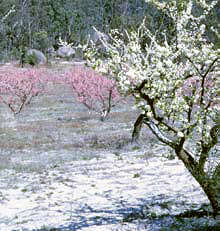
Frank Wright's orchard.
|
|
The Delanty family lived in the Wyberba valley from the 1920s to the 1950s. Tom Delanty built three houses in which he and his sons lived, all located near the present day helipad. Eldest son Dick and his family lived in Bob Boyden's third house, further down the road from his father and brothers, but as this house was too small, he built yet another house. Dick worked with Bob Boyden in the orchards, but became unwell and he, then later his family, moved away.
|
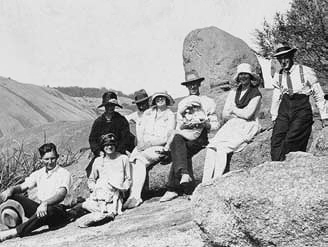
|
|
From left: Alf Delanty, Nell Delanty nursing baby, Mrs Delanty (Bob Boyden's mother), Dick Delanty, Myra Walsh, Harry Thomas nursing baby, Maggie Walsh and Bob Boyden.
Photo taken 1924 on The Pyramid. |
Harry Bernard Thomas (widely known as HB) started farming a 158 acre block from the mid to late 1920s. He cleared the land using horses, wallaby jack and winch. His first house was a bark hut with a bed hanging from the rafters - apparently to keep away from the snakes. He later built other houses, of which one remains today where it was originally built. It is used as Girraween's present-day barracks accommodation.
|
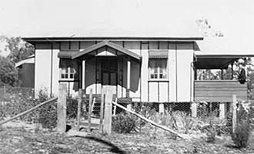
Harry and Jean Thomas's original house.
|
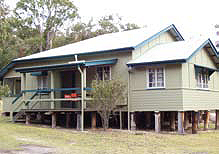
Today's Girraween barracks
accommodation.
|
Harry built other farm buildings, including a packing shed. This shed was later used by Girraween staff as a workshop and was only recently replaced (2007). In 1950, Harry built the weir on Bald Rock Creek and used this water supply on his vegetable crops. Harry was a successful farmer of stone fruit, apples, grapes and vegetables and, in the early days, he even tried growing tobacco.
|
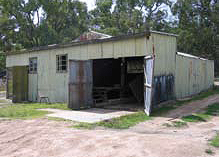
Harry's packing shed.
|

Today's workshop.
|
When Harry retired in 1970, he and his wife Jean moved to Bundaberg, leaving their eldest son John and his wife Anne to manage the property. In January 1977, it was sold to the Wilmott family. In July 1977, it was resumed by the Crown for national park.
From the early 1930s to the mid 1940s, the Gunn family lived in Ericdale. Second son Jack bought Frank Wright's property in 1940. Several years later, Napier "Boy" Gunn bought this same block from his son and relocated a house from Glen Aplin to where it still stands, today - opposite the Girraween Visitor Information Centre. The Gunn family lived in this house until 1965, when they sold to the government. Appropriately-named Gunn's Cottage was then used by park staff to live in. The building is currently used for slide shows and other educational purposes.
|
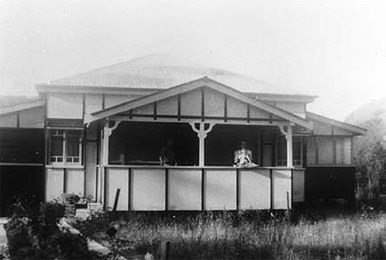
Gunn's Cottage, 1960s.
|
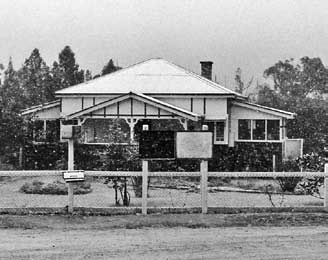
Gunn's Cottage, 1978.
|
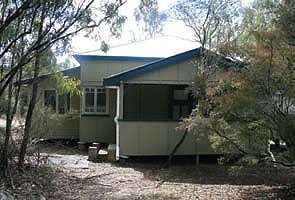
Gunn's Cottage, 2008.
|
There were a number of other houses scattered throughout the area of today's Girraween National Park - owned by Les Rice, Ted Bren, Ken Taylor, Hughie and Arthur McCall, Ray Prentice and Cleve Hayden.
|
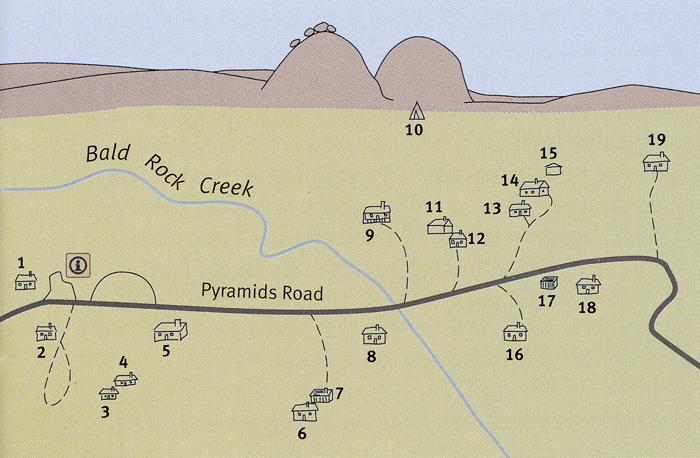
The Wyberba Farms.
|
i
1.
2.
3.
4.
5.
6.
7.
8.
9.
|
Visitor Information Center
Gunn's Cottage
Wright's house
Delanty's first house
Delanty's second house
Delanty's third house
Thomas's house (current barracks)
Thomas's slab house
Garth Thomas's house
Taylor's house (Ericdale)
|
|
10.
11.
12.
13.
14.
15.
16.
17.
18.
19.
|
A frame house
Dick Delanty's house
Bob Boyden's fourth house
Hock Goebel's house
Goebel's main house
Goebel's "red hut"
Bob Boyden's third house
Bob Boyden's second house
Les Rice's house
Bill Goebel's house
|
|

